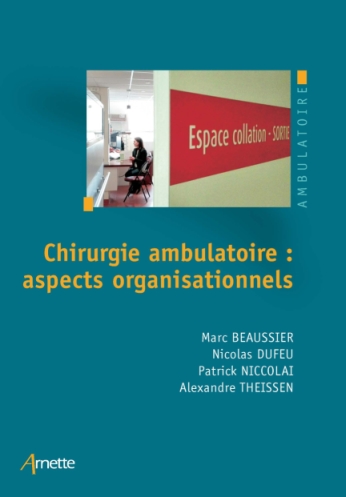(for any order > 35€)
A pragmatic working tool delivering paths of action and improvement for an organisational approach at each step in management
When possible, outpatient surgery is now considered to be the best way to manage a patient prior to an operation. This book presents the importance of optimal organisation of outpatient surgery units; it reviews the principles and requirements, and responds to three fundamental questions: Which patient? Which procedure? Which structure?
The organisation of sites, the technological environment and medical-administrative guidance are essential factors in management. A well conducted policy of evaluation of practices, risk management and quality assurance will ensure effective, safe functioning. In fact, not exposing the patient to an increased risk is one of the major preoccupations in outpatient surgery.
Addressing all of these subjects, the work provides a step-by-step guide for care technicians and decision makers, throughout the patient’s course of surgery, setting out to optimise each of the steps. Its presentation in the form of sheets makes consultation easy and effective. Each sheet is accompanied by practical recommendations and useful digital supplements, videos, or legal texts.
Contents
----------------------
• Chapter 1. General information
• Chapter 2. Why develop outpatient surgery?
• Chapter 3. Principles and requirements
• Chapter 4. Selection of patients
• Chapter 5. Which procedures?
• Chapter 6. Scheduling activity
• Chapter 7. Preparation of the patient for the intervention
• Chapter 8. Location and geographic organisation of the UCA
• Chapter 9. Course of the patient
• Chapter 10. Continuity of care and monitoring after discharge
• Chapter 11. Piloting of UCA
• Chapter 12. Risk management in outpatient surgery
• Chapter 13. Loss ratio and medical-legal aspects
Appendices
1. Outpatient passport given at reception ▪ 2.Information sheet before operation ▪
3. Instructions before intervention in outpatient surgery ▪ 4. Recommendations after anaesthesia in outpatient surgery ▪ 5. Anaesthesia report ▪ 6. Questionnaire on hospitalisation – Nurse preparation ▪ 7. Contact text message before and after operation
Marc Beaussier
Le Professeur Marc Beaussier est anesthésiste-réanimateur, chef du Service d’anesthésie-réanimation de l’Hôpital Saint-Antoine (APHP). Il dirige le Comité ambulatoire de la Société française d’anesthésie-réanimation et coordonne le DIU « Procédure en anesthésie et chirurgie ambulatoire ». Il est par ailleurs membre de l’Observatoire régional de la chirurgie ambulatoire (ORCA) au sein de l’ARS Île-de-France et de la Collégiale de chirurgie ambulatoire de l’APHP. Il a participé à de nombreux travaux et publié de nombreux articles sur la chirurgie ambulatoire.
Nicolas Dufeu
Le Docteur Nicolas Dufeu est anesthésiste-réanimateur. Il est l’ancien responsable de l’Unité de chirurgie ambulatoire de l’hôpital Saint-Antoine (APHP). Le Dr Dufeu a participé à l’élaboration des recommandations de 2009 sur la Chirurgie Ambulatoire et a été à l’origine de la création du congrès VIDEOCAA. Il est membre du comité ambulatoire de la SFAR et consultant auprès de l’Assistance publique de Marseille. Il est également président fondateur de la société Chirurgie ambulatoire conseil et a beaucoup communiqué sur la chirurgie ambulatoire.
Patrick Niccolai
Le Docteur Patrick Niccolai est ancien chef de service d’Anesthésie et chirurgie ambulatoire au Centre hospitalier Princesse Grace, à Monaco, et également consultant senior en management des établissements de santé. Il a été membre du comité de chirurgie ambulatoire de la SFAR et est coorganisateur du congrès VIDEOCAA.
Alexandre Theissen
Le Docteur Alexandre Theissen est médecin anesthésiste-réanimateur et chef de service adjoint au Centre hospitalier Princesse Grace, à Monaco. Il fait partie du comité d’organisation de VIDEOCAA. Il est membre du comité Analyse et maîtrise des risques de la SFAR, et également expert judiciaire près de la cour administrative d’appel de Marseille et des tribunaux de ressort.
